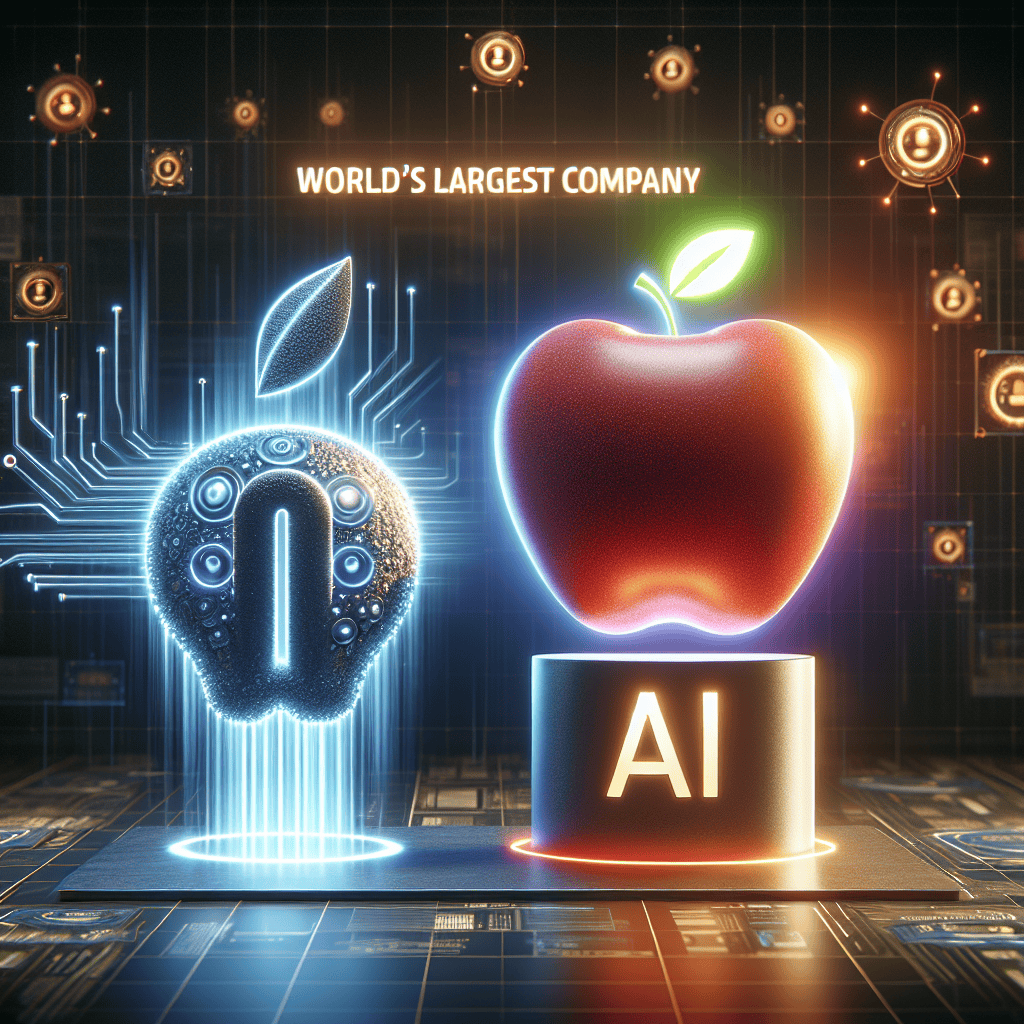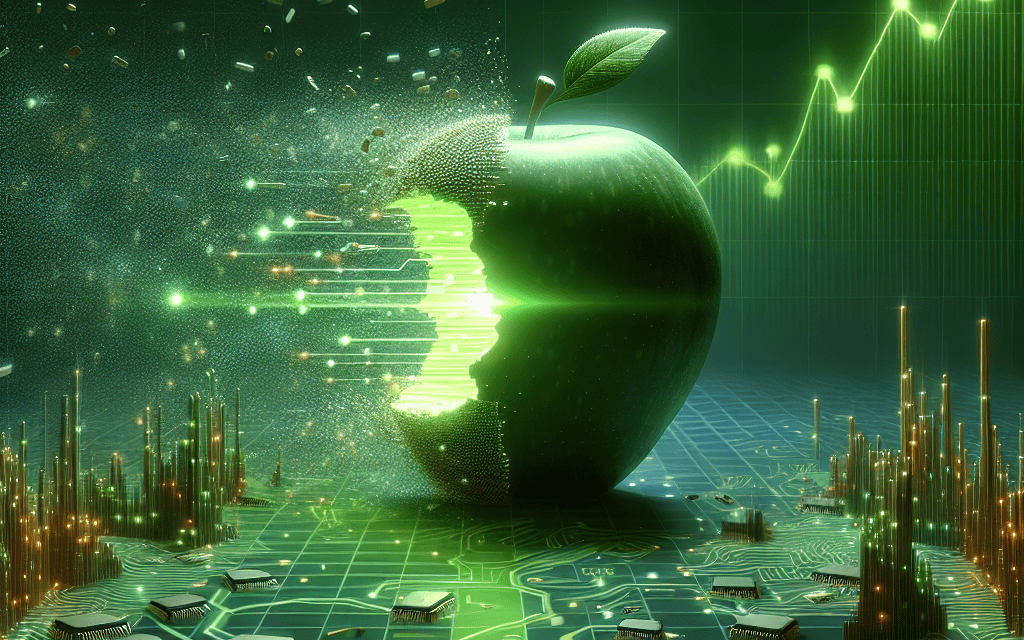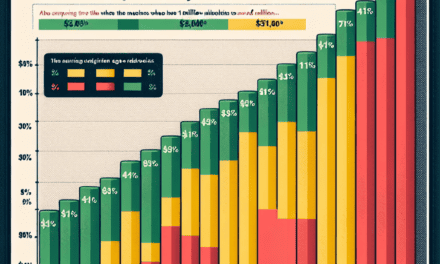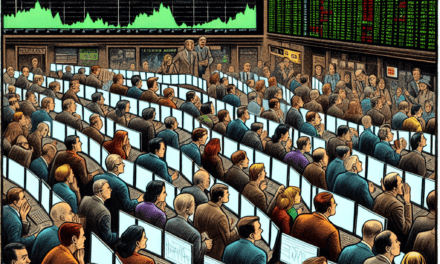“Powering the Future: Nvidia Overtakes Apple as AI Revolution Redefines Market Leadership”
Introduction
In a groundbreaking shift within the global technology landscape, Nvidia has surpassed Apple to become the world’s largest company by market capitalization, driven by an unprecedented surge in demand for artificial intelligence (AI) technologies. This remarkable achievement underscores Nvidia’s pivotal role in the AI revolution, as its advanced graphics processing units (GPUs) and AI-driven solutions have become integral to a wide array of industries, from autonomous vehicles to data centers. The company’s strategic focus on AI innovation and its ability to capitalize on the growing need for high-performance computing have propelled it to the forefront of the tech industry, marking a significant milestone in its evolution and highlighting the transformative impact of AI on the global economy.
Nvidia’s Rise: Key Factors Behind Surpassing Apple
Nvidia’s recent ascension to the position of the world’s largest company, surpassing tech giant Apple, marks a significant milestone in the rapidly evolving landscape of technology and artificial intelligence. This remarkable achievement can be attributed to a confluence of strategic decisions, market dynamics, and technological advancements that have propelled Nvidia to the forefront of the industry. As we delve into the key factors behind Nvidia’s rise, it becomes evident that the company’s success is not merely a result of fortuitous circumstances but rather a testament to its visionary leadership and innovative prowess.
To begin with, Nvidia’s strategic focus on artificial intelligence (AI) has been a pivotal factor in its meteoric rise. The company recognized early on the transformative potential of AI and invested heavily in developing cutting-edge technologies that cater to this burgeoning field. By positioning itself as a leader in AI hardware and software solutions, Nvidia has been able to capitalize on the growing demand for AI-driven applications across various sectors, including healthcare, automotive, and finance. This foresight has not only bolstered Nvidia’s market position but has also enabled it to capture a significant share of the AI market, which is projected to continue expanding at an unprecedented rate.
Moreover, Nvidia’s commitment to innovation has played a crucial role in its ascent. The company’s relentless pursuit of technological excellence is exemplified by its development of the Graphics Processing Unit (GPU), which has become the cornerstone of modern AI and machine learning applications. Unlike traditional Central Processing Units (CPUs), GPUs are designed to handle parallel processing tasks, making them ideal for the complex computations required in AI algorithms. This technological edge has given Nvidia a competitive advantage, allowing it to cater to the needs of AI researchers and developers who rely on high-performance computing solutions.
In addition to its technological innovations, Nvidia’s strategic partnerships and acquisitions have further solidified its position as a leader in the AI space. By collaborating with industry giants and acquiring promising startups, Nvidia has been able to expand its ecosystem and enhance its product offerings. These strategic moves have not only diversified Nvidia’s revenue streams but have also enabled the company to stay ahead of the curve in an increasingly competitive market. As a result, Nvidia has been able to maintain its growth trajectory and continue its upward momentum.
Furthermore, the global shift towards digitalization and automation has created a fertile ground for Nvidia’s growth. As businesses and industries increasingly adopt AI-driven solutions to enhance efficiency and productivity, the demand for Nvidia’s products and services has surged. This trend has been further accelerated by the COVID-19 pandemic, which has underscored the importance of digital transformation and AI in navigating the challenges of a rapidly changing world. Consequently, Nvidia has been well-positioned to capitalize on these opportunities, further cementing its status as a dominant player in the tech industry.
In conclusion, Nvidia’s rise to become the world’s largest company, surpassing Apple, is a testament to its strategic vision, technological innovation, and ability to adapt to changing market dynamics. By focusing on AI and leveraging its strengths in GPU technology, Nvidia has successfully positioned itself at the forefront of the AI revolution. As the demand for AI-driven solutions continues to grow, Nvidia’s leadership in this space is likely to remain unchallenged, paving the way for continued success in the years to come.
The Role of AI in Nvidia’s Market Dominance
Nvidia’s recent ascension to the position of the world’s largest company, surpassing even the tech giant Apple, marks a significant milestone in the rapidly evolving landscape of artificial intelligence (AI) and its impact on global markets. This remarkable achievement underscores the pivotal role that AI plays in shaping the future of technology and business. As AI continues to revolutionize various industries, Nvidia’s strategic focus on this transformative technology has propelled it to the forefront of the corporate world.
The foundation of Nvidia’s market dominance lies in its innovative approach to AI hardware and software solutions. The company’s graphics processing units (GPUs) have become the cornerstone of AI development, providing the computational power necessary for training complex machine learning models. Unlike traditional central processing units (CPUs), GPUs are designed to handle parallel processing tasks efficiently, making them ideal for the demands of AI workloads. This technological advantage has positioned Nvidia as a leader in the AI hardware market, enabling it to capture a significant share of the burgeoning demand for AI solutions.
Moreover, Nvidia’s commitment to research and development has further solidified its position as a key player in the AI industry. By investing heavily in cutting-edge technologies, the company has consistently pushed the boundaries of what is possible with AI. For instance, Nvidia’s development of specialized AI chips, such as the Tensor Core GPUs, has enhanced the performance and efficiency of AI applications across various sectors. These advancements have not only bolstered Nvidia’s product offerings but have also set new standards for the industry, compelling competitors to follow suit.
In addition to its hardware innovations, Nvidia has strategically expanded its software ecosystem to support AI development. The company’s CUDA platform, a parallel computing architecture, has become a vital tool for developers working on AI projects. By providing a robust and flexible framework for building AI applications, Nvidia has fostered a thriving community of developers and researchers who rely on its technology to drive innovation. This symbiotic relationship between Nvidia and the AI community has created a virtuous cycle of growth and development, further cementing the company’s market leadership.
Furthermore, Nvidia’s strategic partnerships and acquisitions have played a crucial role in its rise to prominence. By collaborating with leading technology companies and acquiring promising startups, Nvidia has expanded its reach and influence in the AI domain. These alliances have enabled the company to integrate its technology into a wide range of applications, from autonomous vehicles to healthcare, thereby broadening its market presence and diversifying its revenue streams.
As AI continues to permeate various aspects of modern life, Nvidia’s market dominance is likely to persist. The company’s ability to anticipate and adapt to emerging trends in AI has positioned it as a key enabler of the digital transformation sweeping across industries. By maintaining its focus on innovation and strategic growth, Nvidia is well-equipped to navigate the challenges and opportunities that lie ahead in the AI-driven future.
In conclusion, Nvidia’s rise to become the world’s largest company is a testament to the transformative power of AI and the company’s strategic vision. Through its pioneering hardware and software solutions, commitment to research and development, and strategic partnerships, Nvidia has established itself as a leader in the AI industry. As the demand for AI technologies continues to grow, Nvidia’s market dominance is poised to endure, shaping the future of technology and business in profound ways.
Comparing Business Strategies: Nvidia vs. Apple
In the rapidly evolving landscape of technology, the recent shift in market dynamics has seen Nvidia surpass Apple to become the world’s largest company, a development that underscores the transformative power of artificial intelligence (AI). This remarkable achievement is not merely a reflection of Nvidia’s prowess in the semiconductor industry but also highlights the contrasting business strategies employed by Nvidia and Apple, two giants that have long been at the forefront of innovation.
Nvidia’s ascent can be attributed to its strategic focus on AI and machine learning, areas that have seen exponential growth in recent years. The company’s investment in developing cutting-edge graphics processing units (GPUs) has positioned it as a leader in AI hardware, a sector that is increasingly critical as industries across the globe integrate AI into their operations. By capitalizing on the demand for high-performance computing, Nvidia has successfully expanded its market reach beyond traditional gaming applications to include data centers, autonomous vehicles, and other AI-driven technologies. This diversification strategy has not only bolstered Nvidia’s revenue streams but also solidified its reputation as a key enabler of the AI revolution.
In contrast, Apple’s business strategy has historically centered around creating a seamless ecosystem of consumer electronics, software, and services. The company’s focus on design, user experience, and brand loyalty has resulted in a robust product lineup that includes the iPhone, iPad, Mac, and Apple Watch, among others. While Apple has ventured into AI with features like Siri and machine learning capabilities integrated into its devices, its approach has been more incremental compared to Nvidia’s aggressive push into AI infrastructure. Apple’s strategy of maintaining tight control over its hardware and software ecosystem has allowed it to deliver a consistent user experience, but it has also limited its exposure to the broader AI market that Nvidia has tapped into.
Despite these differences, both companies have demonstrated an ability to adapt to changing market conditions. Apple’s recent foray into augmented reality (AR) and virtual reality (VR) with the introduction of the Vision Pro headset indicates a willingness to explore new frontiers, potentially setting the stage for future growth in immersive technologies. Meanwhile, Nvidia’s continued investment in AI research and development, as well as strategic partnerships with major tech firms, underscores its commitment to maintaining its leadership position in the AI domain.
The contrasting strategies of Nvidia and Apple also reflect broader trends in the technology sector, where the convergence of hardware and software is driving innovation. As AI becomes increasingly integral to various industries, companies that can effectively harness its potential are likely to gain a competitive edge. Nvidia’s success in this regard serves as a testament to the importance of aligning business strategy with emerging technological trends.
In conclusion, the rise of Nvidia as the world’s largest company amid the AI boom highlights the significance of strategic foresight and adaptability in the technology industry. While Apple remains a formidable player with a strong consumer base and a diverse product portfolio, Nvidia’s focus on AI infrastructure has propelled it to new heights. As both companies continue to navigate the complexities of the digital age, their differing approaches offer valuable insights into the evolving nature of business strategy in a world increasingly shaped by artificial intelligence.
How Nvidia’s Innovations Propel Its Market Value

Nvidia’s recent ascension to the position of the world’s largest company, surpassing even tech giant Apple, marks a significant milestone in the rapidly evolving landscape of technology and artificial intelligence. This remarkable achievement is not merely a reflection of market dynamics but a testament to Nvidia’s relentless innovation and strategic foresight in the realm of AI and computing. As the demand for AI-driven solutions continues to surge, Nvidia’s pioneering advancements in graphics processing units (GPUs) and AI technologies have positioned it at the forefront of this transformative wave.
Central to Nvidia’s success is its ability to anticipate and adapt to the shifting technological paradigm. The company’s GPUs, originally designed for rendering graphics in video games, have found a new and critical role in AI applications. These powerful processors are now indispensable in training complex machine learning models, enabling breakthroughs in fields ranging from autonomous vehicles to healthcare diagnostics. By capitalizing on this versatility, Nvidia has effectively expanded its market reach, tapping into industries that are increasingly reliant on AI to drive innovation and efficiency.
Moreover, Nvidia’s strategic investments in research and development have been instrumental in maintaining its competitive edge. The company has consistently pushed the boundaries of GPU capabilities, introducing architectures that deliver unprecedented performance and energy efficiency. This commitment to innovation has not only solidified Nvidia’s dominance in the GPU market but has also facilitated the development of cutting-edge AI platforms. For instance, the Nvidia DGX systems, designed specifically for AI research, have become a cornerstone for organizations seeking to harness the power of AI for complex data analysis and decision-making processes.
In addition to its hardware prowess, Nvidia’s software ecosystem has played a crucial role in its ascent. The company’s CUDA platform, a parallel computing architecture, has become the industry standard for developing AI applications. By providing developers with the tools and resources needed to optimize their algorithms for Nvidia’s GPUs, the company has fostered a vibrant community of innovators who continue to push the boundaries of what is possible with AI. This symbiotic relationship between hardware and software has created a robust foundation for Nvidia’s sustained growth and market leadership.
Furthermore, Nvidia’s strategic partnerships and acquisitions have bolstered its position in the AI landscape. By collaborating with leading technology companies and acquiring key players in the AI and semiconductor industries, Nvidia has expanded its capabilities and market presence. These alliances have not only enhanced Nvidia’s product offerings but have also facilitated the integration of its technologies into a broader range of applications, from cloud computing to edge devices.
As Nvidia continues to ride the wave of the AI boom, its market value reflects the growing recognition of its pivotal role in shaping the future of technology. The company’s ability to innovate and adapt to emerging trends has not only propelled it to the top of the corporate hierarchy but has also set a benchmark for others in the industry. As AI becomes increasingly integral to various sectors, Nvidia’s leadership in this domain underscores the transformative potential of its technologies and the profound impact they are poised to have on the global economy. In this era of rapid technological advancement, Nvidia’s journey serves as a compelling narrative of innovation, strategic vision, and the relentless pursuit of excellence.
The Impact of AI Boom on Global Tech Companies
In recent years, the rapid advancement of artificial intelligence (AI) has significantly reshaped the landscape of global technology companies. Among the most notable developments is Nvidia’s remarkable ascent to become the world’s largest company, surpassing even the tech giant Apple. This shift underscores the profound impact that AI is having on the tech industry, as well as the broader economic implications of this technological revolution.
Nvidia’s rise to prominence can be attributed to its strategic focus on AI and its related technologies. The company’s graphics processing units (GPUs) have become essential components in the development and deployment of AI applications, ranging from machine learning to data analytics. As AI continues to permeate various sectors, the demand for Nvidia’s products has surged, propelling the company to new heights in terms of market capitalization. This growth is not only a testament to Nvidia’s innovative capabilities but also highlights the increasing importance of AI in driving economic value.
In contrast, Apple’s business model, while still robust, is more heavily reliant on consumer electronics and services. Although Apple has made strides in integrating AI into its products, such as through the development of Siri and other smart features, its core revenue streams remain tied to hardware sales. As a result, the company has not experienced the same level of growth as Nvidia in the context of the AI boom. This divergence illustrates how companies that are more deeply embedded in the AI ecosystem are better positioned to capitalize on the current technological wave.
Moreover, the AI boom has broader implications for the global tech industry. As AI technologies become more sophisticated and widespread, companies across various sectors are increasingly investing in AI capabilities to enhance their operations and gain a competitive edge. This trend is driving a shift in the tech landscape, where traditional hardware and software companies are being challenged by those that are more agile and focused on AI innovation. Consequently, the competitive dynamics within the industry are evolving, with new players emerging and established companies being forced to adapt.
Furthermore, the economic impact of AI extends beyond the tech industry itself. As AI technologies are integrated into sectors such as healthcare, finance, and manufacturing, they are driving efficiencies and creating new opportunities for growth. This has the potential to transform entire industries, leading to increased productivity and economic output. However, it also raises important questions about the future of work and the need for policies that address the potential displacement of jobs due to automation.
In conclusion, Nvidia’s emergence as the world’s largest company amid the AI boom is a clear indication of the transformative power of artificial intelligence. As AI continues to evolve and reshape industries, companies that are able to harness its potential will likely emerge as leaders in the new economic landscape. This shift not only highlights the importance of innovation and adaptability in the tech industry but also underscores the broader economic and societal implications of AI. As we move forward, it will be crucial for businesses, policymakers, and society as a whole to navigate these changes thoughtfully and strategically, ensuring that the benefits of AI are realized while addressing the challenges it presents.
Nvidia’s Growth Trajectory: Lessons for Investors
Nvidia’s recent ascension to the position of the world’s largest company, surpassing even the tech giant Apple, marks a significant milestone in the rapidly evolving landscape of technology and investment. This remarkable achievement is largely attributed to the burgeoning demand for artificial intelligence (AI) technologies, which Nvidia has adeptly capitalized on. For investors, Nvidia’s growth trajectory offers valuable lessons on the importance of strategic foresight, innovation, and adaptability in an ever-changing market.
To begin with, Nvidia’s success underscores the critical role of strategic foresight in identifying and capitalizing on emerging trends. The company’s early recognition of the potential of AI and its subsequent investment in developing cutting-edge graphics processing units (GPUs) positioned it as a leader in the AI hardware market. This foresight allowed Nvidia to establish a strong foothold in a sector that has seen exponential growth, driven by the increasing adoption of AI across various industries. Investors can glean from this the importance of staying ahead of the curve by identifying nascent trends and positioning themselves to benefit from future growth.
Moreover, Nvidia’s commitment to innovation has been a key driver of its success. The company’s relentless pursuit of technological advancements has resulted in the development of GPUs that are not only powerful but also versatile, catering to a wide range of applications from gaming to data centers and autonomous vehicles. This focus on innovation has enabled Nvidia to maintain a competitive edge in a highly dynamic market. For investors, this highlights the significance of investing in companies that prioritize research and development, as continuous innovation is essential for sustaining long-term growth and competitiveness.
In addition to strategic foresight and innovation, Nvidia’s adaptability has played a crucial role in its rise to prominence. The company has demonstrated an impressive ability to pivot and adapt its business model in response to changing market dynamics. For instance, Nvidia’s shift from a primary focus on gaming to a broader emphasis on AI and data center solutions exemplifies its agility in navigating new opportunities. This adaptability has allowed Nvidia to diversify its revenue streams and mitigate risks associated with reliance on a single market segment. Investors can learn from this the importance of flexibility and diversification in building a resilient investment portfolio.
Furthermore, Nvidia’s growth trajectory highlights the impact of strategic partnerships and collaborations. By forging alliances with leading technology companies and research institutions, Nvidia has been able to accelerate its innovation efforts and expand its market reach. These partnerships have facilitated the integration of Nvidia’s technologies into a wide array of applications, further solidifying its position as a leader in the AI space. For investors, this underscores the value of investing in companies that actively seek collaborative opportunities to enhance their capabilities and drive growth.
In conclusion, Nvidia’s rise to become the world’s largest company amid the AI boom offers several important lessons for investors. The company’s strategic foresight, commitment to innovation, adaptability, and emphasis on strategic partnerships have been instrumental in its success. As the technology landscape continues to evolve, investors would do well to consider these factors when evaluating potential investment opportunities. By doing so, they can position themselves to capitalize on emerging trends and achieve sustainable growth in an increasingly competitive market.
Future Prospects: Can Nvidia Maintain Its Lead Over Apple?
Nvidia’s recent ascension to the position of the world’s largest company, surpassing tech giant Apple, marks a significant milestone in the rapidly evolving landscape of technology and artificial intelligence. This remarkable achievement is largely attributed to the burgeoning demand for AI technologies, which has propelled Nvidia to the forefront of the industry. As the company continues to ride the wave of AI innovation, the question arises: can Nvidia maintain its lead over Apple in the long term?
To understand Nvidia’s current position, it is essential to examine the factors that have contributed to its meteoric rise. At the heart of Nvidia’s success is its pioneering work in graphics processing units (GPUs), which have become indispensable in the development and deployment of AI applications. These GPUs are not only crucial for gaming and graphics but also serve as the backbone for AI computations, enabling faster and more efficient processing of complex algorithms. As industries across the globe increasingly integrate AI into their operations, Nvidia’s products have become essential tools, driving the company’s growth and market valuation.
Moreover, Nvidia’s strategic investments and acquisitions have further solidified its dominance in the AI sector. The company’s acquisition of Mellanox Technologies, a leader in high-performance computing and networking, has enhanced its capabilities in data center solutions, a critical component of AI infrastructure. Additionally, Nvidia’s partnership with leading cloud service providers has expanded its reach, allowing it to tap into a broader customer base and diversify its revenue streams. These strategic moves have positioned Nvidia as a key player in the AI ecosystem, providing it with a competitive edge over its rivals.
However, maintaining its lead over Apple will require Nvidia to navigate several challenges. One of the primary concerns is the intense competition in the tech industry, where companies are constantly innovating to capture market share. Apple, with its vast resources and loyal customer base, remains a formidable competitor. The company has been making significant strides in AI, particularly with its focus on integrating AI capabilities into its products and services. Apple’s emphasis on privacy and user experience could potentially attract consumers who prioritize these aspects, posing a challenge to Nvidia’s dominance.
Furthermore, Nvidia must contend with the ever-evolving regulatory landscape. As governments worldwide scrutinize the tech industry more closely, Nvidia may face increased regulatory hurdles that could impact its operations and growth prospects. Ensuring compliance with these regulations while continuing to innovate will be crucial for Nvidia to sustain its leadership position.
In addition to external challenges, Nvidia must also focus on internal factors to maintain its lead. Investing in research and development will be vital to staying ahead of technological advancements and meeting the growing demands of the AI market. Cultivating a culture of innovation and agility within the organization will enable Nvidia to adapt to changing market dynamics and capitalize on emerging opportunities.
In conclusion, while Nvidia’s rise to become the world’s largest company is a testament to its success in the AI domain, sustaining this lead over Apple will require a multifaceted approach. By leveraging its strengths, addressing challenges, and continuing to innovate, Nvidia can position itself for long-term success in the competitive tech landscape. As the AI boom continues to reshape industries, the future prospects for Nvidia remain promising, provided it can navigate the complexities of the market and maintain its strategic focus.
Q&A
1. **What event led Nvidia to surpass Apple as the world’s largest company?**
Nvidia’s market capitalization surged due to the booming demand for AI technologies, which significantly increased its stock value.
2. **What role did AI play in Nvidia’s rise?**
The AI boom, particularly in sectors like machine learning and data centers, drove up demand for Nvidia’s GPUs, which are essential for AI computations.
3. **How did Nvidia’s stock performance compare to Apple’s during this period?**
Nvidia’s stock experienced a substantial increase, outpacing Apple’s stock performance and contributing to its higher market valuation.
4. **What specific products or technologies contributed to Nvidia’s growth?**
Nvidia’s advanced GPUs and AI-focused hardware and software solutions were key contributors to its growth.
5. **How did the market react to Nvidia’s new position as the largest company?**
The market reacted positively, with increased investor interest and confidence in Nvidia’s future growth prospects in the AI sector.
6. **What impact did this have on Apple’s market position?**
While Apple remained a highly valuable company, it was temporarily overtaken by Nvidia in terms of market capitalization.
7. **What are the potential future implications for Nvidia and the tech industry?**
Nvidia’s rise underscores the growing importance of AI technologies, potentially leading to increased investment and innovation in AI across the tech industry.
Conclusion
Nvidia’s recent surge to become the world’s largest company, surpassing Apple, underscores the transformative impact of artificial intelligence on the global economy. This milestone highlights Nvidia’s strategic positioning and innovation in AI technologies, particularly in graphics processing units (GPUs) that are crucial for AI applications. The company’s growth reflects the increasing demand for AI-driven solutions across various industries, from autonomous vehicles to data centers. Nvidia’s ascent also signals a shift in market dynamics, where technology companies that lead in AI development and deployment are gaining unprecedented value and influence. This development may prompt other tech giants to intensify their focus on AI to maintain competitive advantage, potentially reshaping the landscape of the technology sector.





